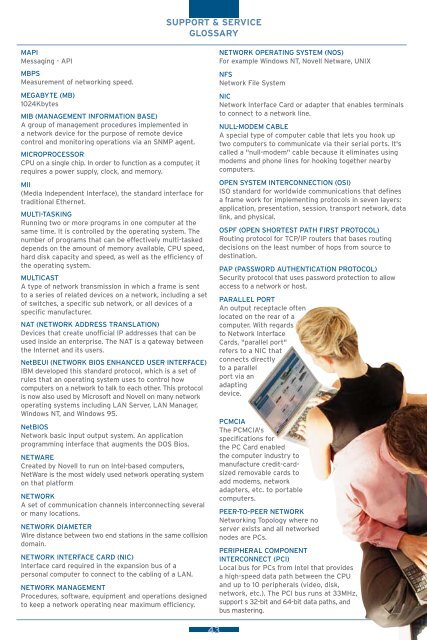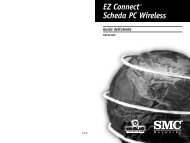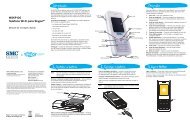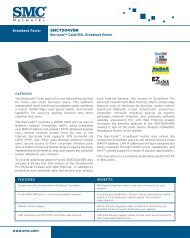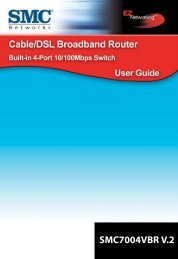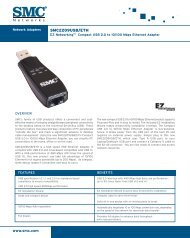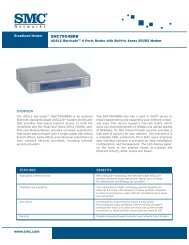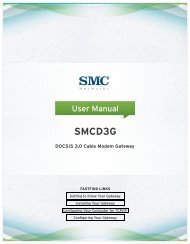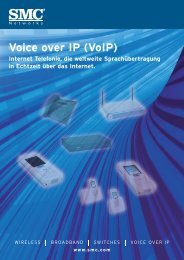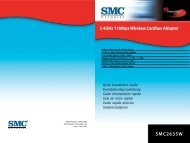PRODUCT CATALOG - SMC
PRODUCT CATALOG - SMC
PRODUCT CATALOG - SMC
You also want an ePaper? Increase the reach of your titles
YUMPU automatically turns print PDFs into web optimized ePapers that Google loves.
MAPI<br />
Messaging - API<br />
MBPS<br />
Measurement of networking speed.<br />
MEGABYTE (MB)<br />
1024Kbytes<br />
MIB (MANAGEMENT INFORMATION BASE)<br />
A group of management procedures implemented in<br />
a network device for the purpose of remote device<br />
control and monitoring operations via an SNMP agent.<br />
MICROPROCESSOR<br />
CPU on a single chip. In order to function as a computer, it<br />
requires a power supply, clock, and memory.<br />
MII<br />
(Media Independent Interface), the standard interface for<br />
traditional Ethernet.<br />
MULTI-TASKING<br />
Running two or more programs in one computer at the<br />
same time. It is controlled by the operating system. The<br />
number of programs that can be effectively multi-tasked<br />
depends on the amount of memory available, CPU speed,<br />
hard disk capacity and speed, as well as the efficiency of<br />
the operating system.<br />
MULTICAST<br />
A type of network transmission in which a frame is sent<br />
to a series of related devices on a network, including a set<br />
of switches, a specific sub network, or all devices of a<br />
specific manufacturer.<br />
NAT (NETWORK ADDRESS TRANSLATION)<br />
Devices that create unofficial IP addresses that can be<br />
used inside an enterprise. The NAT is a gateway between<br />
the Internet and its users.<br />
NetBEUI (NETWORK BIOS ENHANCED USER INTERFACE)<br />
IBM developed this standard protocol, which is a set of<br />
rules that an operating system uses to control how<br />
computers on a network to talk to each other. This protocol<br />
is now also used by Microsoft and Novell on many network<br />
operating systems including LAN Server, LAN Manager,<br />
Windows NT, and Windows 95.<br />
NetBIOS<br />
Network basic input output system. An application<br />
programming interface that augments the DOS Bios.<br />
NETWARE<br />
Created by Novell to run on Intel-based computers,<br />
NetWare is the most widely used network operating system<br />
on that platform<br />
NETWORK<br />
A set of communication channels interconnecting several<br />
or many locations.<br />
NETWORK DIAMETER<br />
Wire distance between two end stations in the same collision<br />
domain.<br />
NETWORK INTERFACE CARD (NIC)<br />
Interface card required in the expansion bus of a<br />
personal computer to connect to the cabling of a LAN.<br />
NETWORK MANAGEMENT<br />
Procedures, software, equipment and operations designed<br />
to keep a network operating near maximum efficiency.<br />
SUPPORT & SERVICE<br />
GLOSSARY<br />
43<br />
NETWORK OPERATING SYSTEM (NOS)<br />
For example Windows NT, Novell Netware, UNIX<br />
NFS<br />
Network File System<br />
NIC<br />
Network Interface Card or adapter that enables terminals<br />
to connect to a network line.<br />
NULL-MODEM CABLE<br />
A special type of computer cable that lets you hook up<br />
two computers to communicate via their serial ports. It's<br />
called a "null-modem" cable because it eliminates using<br />
modems and phone lines for hooking together nearby<br />
computers.<br />
OPEN SYSTEM INTERCONNECTION (OSI)<br />
ISO standard for worldwide communications that defines<br />
a frame work for implementing protocols in seven layers:<br />
application, presentation, session, transport network, data<br />
link, and physical.<br />
OSPF (OPEN SHORTEST PATH FIRST PROTOCOL)<br />
Routing protocol for TCP/IP routers that bases routing<br />
decisions on the least number of hops from source to<br />
destination.<br />
PAP (PASSWORD AUTHENTICATION PROTOCOL)<br />
Security protocol that uses password protection to allow<br />
access to a network or host.<br />
PARALLEL PORT<br />
An output receptacle often<br />
located on the rear of a<br />
computer. With regards<br />
to Network Interface<br />
Cards, "parallel port"<br />
refers to a NIC that<br />
connects directly<br />
to a parallel<br />
port via an<br />
adapting<br />
device.<br />
PCMCIA<br />
The PCMCIA's<br />
specifications for<br />
the PC Card enabled<br />
the computer industry to<br />
manufacture credit-cardsized<br />
removable cards to<br />
add modems, network<br />
adapters, etc. to portable<br />
computers.<br />
PEER-TO-PEER NETWORK<br />
Networking Topology where no<br />
server exists and all networked<br />
nodes are PCs.<br />
PERIPHERAL COMPONENT<br />
INTERCONNECT (PCI)<br />
Local bus for PCs from Intel that provides<br />
a high-speed data path between the CPU<br />
and up to 10 peripherals (video, disk,<br />
network, etc.). The PCI bus runs at 33MHz,<br />
support s 32-bit and 64-bit data paths, and<br />
bus mastering.


